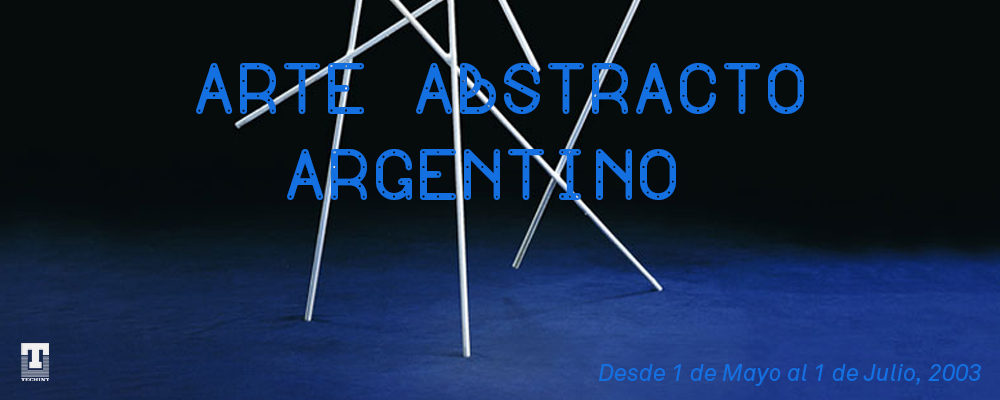Arte Abstracto Argentino
Curador: Marcelo Pacheco - Curador invitado: Enrico Crispolti
Patrocinio: Ministerio degli Affari Esteri, Roma, Ministerio de Relaciones Exteriores de Argentina - Secretaria de Cultura del Gobierno de la Ciudad de Buenos Aires, Embajada de Italia en Argentina.
Auspicio: Tenaris S.A. - Organización Techint
1 de Mayo - 1 de Julio, 2003
--
Argentine abstract art gathers together and for the first time a wide range of works that sprung from assimilating and transmuting the early twentieth century European vanguards into the Argentinean and Uruguayan cultural context.
It is not by chance that this artistic and intellectual dialectic between the old and the new world did find a most favorable ground in the Rio de la Plata, the region of Latin America where the Italian presence has had a greater incidence as of the late nineteenth century.
A history of transmigrations and trans-culturing whose circularity has been plentiful in aesthetic expressions –something this exhibition richly accounts for, since it is first presented in Italy.
We offer the public two articulated instances: one is the exhibit; the other, the catalogue. They complement each other and at the same time, are autonomous ever since the manifestoes and theoretical writings by artists and critics of that time make up a documentary corpus that is decisive for a comprehension of those works exhibited within their historical and cultural context. A chronological ordination, the biography of the artists and an important bibliography add of their own to the relevance of this integral artistic event.
Giacinto di Pietrantonio’s essay offers a reading centered round the metaphor of the journey and transmigration as a constant in the relations between Italy and Argentina –these viewed as an organism of communicating vessels which, in its dynamics, causes the cultures to meet and mix with each other, and finally give life to forms and a language in steadfast transformation.
Marcelo Pacheco, the curator for this exhibition, reinterprets the implications of the artistic debate in the South American countries, from a viewpoint that questions the conceptual and stylistic centralism of the European vanguards and displaces the core of the debate to a contemporary “ex-centricity”.
Then, Adriana Lauría writes on the historical evolution and the multiplicity of responses given by Concrete art, Madi art and Perceptismo to the convulsive panorama of the newly born Riverplatean modernity.
Enrico Crispolti, then, examines the meeting point and the exchange of cultures and ideas embodied by Lucio Fontana. His habitual trips between Italy and Argentina are a connective tissue between the European vanguards and Argentine Abstract art that results in the making up of Espacialismo –which reaches its highest momentum in the Manifiesto Blanco (White Manifesto), written in Buenos Aires in 1946, before Fontana’s definite return to Italy.
Last but not least, the interview with Tomás Maldonado helps recreate the artistic and intellectual atmosphere of the 1940s in Argentina, in a sort of critical balance and synthesis of its historical significance.
This project is the prime fruit of the collaboration between the Modern and Contemporary Art Gallery in Bergamo and Fundación Proa in Buenos Aires. A project born to promote an artistic exchange concerned with the symptoms and emblems of contemporary languages –an attempt to share the most significant findings and the plurality of their quests, beyond frontiers and univocal codes.
Public and private art collections from Argentina, Uruguay, Venezuela, the United States, Switzerland and Italy should be thanked for their generous collaboration in the making of this exhibition and its catalogue.
This great effort would be meaningless if we did not mention the contribution of many people and the wonderful team that the staff of both institutions conformed. Our special thanks to Patricia Artundo and Luis Príamo, for their exacting documentary and photographic research, to Florencia Battisti and Cristina Rossi for the chronological ordination, the artists’ biographies and the bibliography. We also want to thank architects Giuseppe Caruso and Agata Torricella, for the museum displays and the expository installment.
Finally, our liveliest acknowledgment goes to the Asociación de Amigos de la Gamec, Dalmine company and those companies that conform Tenaris –all of them members of Organización Techint– for the enthusiastic and unconditional support we received from them all.
Organiza
Fundación Proa
Galleria D´Arte Moderna e Contemporanea Di Bergamo
Investigación documental
Patricia Artundo
Investigación fotográfica
Luis Priamo
Montaje
Caruso -Torricella Architetti Milano
Asistentes
Juan Ades
Melisa Cámera
Textos
Marcelo Pacheco
Adriana Lauría
Enrico Crispolti
Giacinto Di Pietrantonio
Traducciones
Javier Barreiro Cavestany
Alicia Lerda Zanotti
Claudia Cervetto
Paola Aimo
Diseño
Willy Goldshmidt
Alejandro de Ilzarbe
Auspicia
Tenaris S.A.
Organización Techint

